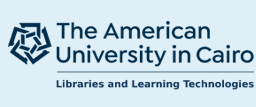-

Participation and community in the Egyptian new lands: The case of South Tahrir
Nicholas Hopkins, Abderrahim ElHaydary, Salah El Zoghby, and Hanaa Singer
-

Informal Communities in Cairo: The Basis of a Typology
Linda Oldham, Haguer El Hadidi, and Hussein Tamaa
-

Philosophy, ethics, and virtuous rule: A study of Averroes' Commentary on Plato's "Republic"
Charles E. Butterworth
-

An analytic index of survey research in Egypt
Madiha El Safty, Monte Palmer, and Mark Kennedy
The objective of the present volume is to provide planners and scholars with an analytical summary of some of the most important survey research projects that have been completed in Egypt over the course of the past twenty years.
-

Basic needs, inflation, and the poor of Egypt, 1970-1980
Myrette Ahmed El Sokkari
The aim of the study is to see how the poor have fared over the 1970's: to evaluate whether their welfare improved or worsened. The cost of the private consumption goods will be estimated over the period of 1970-1982 using detailed information on the cost of food, clothing, and shelter for both urban and rural areas.
-

Social security and the family in Egypt
Helmi R. Tadros
This study is based on the research project entitled"The Role of Social and Economic Security in Family and Community Life", conducted by the Social Research Center (SRC) of the American University in Cairo in collaboration with the Mershon Center of the Ohio State University.
-

The Nationalization of Arabic and Islamic Education in Egypt: Dar Al Alum and Al Azhar
Lois A. Aroian
This study sets forth for the first time the vital role of Dar Al'ulum, Egypt's first and only continuously operating university level teaching training institution, in the nationalization of Islamic and Arabic education in Egypt. Ali Mubarak, nineteenth century Egypt's longest enduring bureaucrat, initiated , and Khedive Ismail (1863-1879) founded Dar al Ulum in 1892 to train teachers of Arabic and Turkish for the newly expanding national (amiriyya) school system. This study grew out of a PhD dissertation, "Education, Language and Culture in Modern Egypt: Dar Al Ulum and its Graduates (1872-1923)" presented at The University of Michigin in 1978.
-

Export of Egyptian school teachers
Suzanne A. Messiha
Migration is a complex social phenomenon whose causes, motivations and consequences are diverse. The economist, therefore, cannot presume the monopoly of its explanation. He, like specialists of other disciplines, emphasizes the variables of his concern. This monograph treats migration from an economic point of view; migration is conceptualized as a means of promoting efficient utilization of resources., an fovestment aiming at increasing the productivity of human resources, an investment which has costs and which also generates return (Schultz, 1971: 18, Bowan et al, 1967:875-98; Sjaastad, 1962:8-83.) It is an attempt to appraise Egypt's policy to invest in huma.n capital through export, i.e. cost-benefit analysis. Both the internal rate of return and the net present value criteria have been used to test the hypothesis that seconding Egyptian school teachers to Saudia Arabia and Kuwait is profitable for Egypt as the emigration country. From the private welfare perspective, the objective function is to maximize the income of a particular group, and from the development perspective, the objective function is to maximize gross domestic product. The research outline in treating this subject has been as follows: In part one, we examine the demand for Egyptian labor in Arab countries. giving different estimates of the number of Egyptians actually working there. Then we discuss the triad of Egypt's economic problems (foreign exchange shortage, population pressure, and surplus labor) which have been plaguing the economy since the sixties, and which gathered momentum in the seventies to finally compel the Egyptian government to resort to liberalization of migration as an outlet. From this, we proceed in part 2 to review the evolution of Egypt's migration policy since the Revolution. In this period, the tone of official Egyptian policy has ranged from antagonism, to ambivalence to liberalization. The reference to policy includes migration policies,secondment policies, and remittances policies. Having discussed Egypt's migratjon policy, we turn in part 3 to a survey of status of migration theory and its recent appfication to migration. This survey consists of listing the different approaches used in the study of emigration phenomenon and the perspective followed in this study (human capital approach:empirical application). Part 4 contains a detailed explanation of the methodology used in this study, its relevance and limitations. The hypothesis which·;: to be tested within the framework of the private welfare perspective and the development perspective is spelled out, followed by the sources of data for empirical application of the model. In part 5, the Saudi Arabian survey is examined. This survey is examined in relation to the construction of the questionnaire schedules, the respondents' characteristics, attitudes, preferences and expenditures pattern abroad and upon return to Egypt. This survey focuses primarily on the importance of remittances and repatriated earnings of the respondents and of the original population as a whole and their magnitude and significance relative to the Egyptian economy. This chapter also includes an assessment of Egypt's remittance policy in light of our findings. The same pattern of analysis has been pursued in part 6 for the Kuwaiti case. In part 7, an attempt is made to apply the model empirically to our findings in the two surveys within the framework of the private welfare and development perspectives and to interpret the results in part 8, our conclusions are presented and policy recommendations based on our findings are proposed.
Printing is not supported at the primary Gallery Thumbnail page. Please first navigate to a specific Image before printing.













